
$100 Worth Of Groceries Makes This Man Go On Helpless Rant: “I’m Literally Shaking From Shock”
InterviewYou might have heard that we’re on some sort of streak of cooling inflation. And while that is great news, one can only get a sense of the actual figures – food prices climbed 8.5% from March 2022 to March 2023 and keep decreasing only by 0.1% each month – by realizing how much you need to shell out for basic goods in this day and age.
In a viral video that has been viewed over 236,000 times, a San Diego-based TikToker shared his bewilderment after doing a quick grocery run. “This is getting out of hand,” Carenstino said in his video. “It’s to a point where people can’t live.” Surely, as you can tell by the popularity of the video, he’s not alone in feeling frustrated about the current economical situation which is far from being how we remember it.
After doing a quick grocery run which cost $100, this man didn’t hold out from venting his frustration in a viral TikTok
Image credits: carenstino
“This is getting out of hand. It’s to a point where people can’t live. And I just want to show you something. This right here. I just went grocery shopping for very basic things, very basic. This amounted to $100. You’re telling me this is $100?”
Image credits: carenstino
“This is barely anything to feed me for a couple days. Literally just some chicken, eggs, rice, these things, and some juices, body wash, deodorant, some thank you cards and seaweed, $100 for this. Excuse me?”
Image credits: carenstino
Image credits: carenstino
Here’s the viral video in full
@carenstino Im literally shaking from shock… something needs to change #fyp#fypシ#inflation#cantaffordtoeat♬ original sound – Carenstino
Image credits: Karolina Grabowska (not the actual photo)
While being shaken to the core might sound like an exaggeration for dramatic effect, realizing just how bad inflation has been for our all-time favorite groceries begs for such a reaction. Egg prices, for example, increased by an eye-popping 70% over the last year. A loaf of white bread, the staple component of the American diet, was also done dirty by inflation, as it saw its prices climb by 22% compared to 2021. And if you want to see proof of the rising cost of living, then go no further than your local shop’s dairy aisle.
According to CNN, between January 2022 and January 2023, groceries got 11.3% more expensive – the highest yearly percent change since 1974. Compared to the last two decades, when average year-to-year food price inflation was a stable 2%, hearing that grocery bills will keep increasing until the end of the year – although “more slowly in 2023 than in 2022 but still at above historical-average rates” – doesn’t certainly put us at ease.
However, while we do have the undeniable numbers that things are not improving (and that we might never taste oat milk if things keep going that way), behavioral economists say the so-called ‘inflationary psychology’ also has a play in how much inflation scares us. Meg Elkins, in an article for The Conversation, highlights this notion: “As behavioral economists, we can see the dilemma in warning about inflationary psychology, given the very concept is about self-fulfilling prophecies.”
While Elkins argues that we’re doing fine at the moment, she also highlights that we, humans, are pretty susceptible to panic which can only drive the prices up because, of course, for companies, that only means more opportunities to make a profit.
Turns out, there’s little consumers can do to prevent food companies from raising their prices
Image credits: Anna Shvets (not the actual photo)
Manufacturers, meanwhile, have been blaming everything from higher labor costs to transportation delays for an eye-watering spike in grocery prices. And while that sounds like a solid explanation, considering that we were just about to get back to where we came from pre-COVID days until the Russia-Ukraine war kicked off, Chris Becker, senior economist at the Groundwork Collaborative, a progressive economic advocacy organization, believes it’s all smoke and mirrors.
“Part of the story was that we had huge disruptions in our economy like the pandemic, the war in Ukraine that did for a long time drive up costs that businesses were facing. That’s certainly a big cause of inflation is these supply disruptions,” Becker explained to Bored Panda over the phone. “But then what we saw is that these corporations were explicitly talking about the fact that they could use the pandemic, the war in Ukraine as an excuse to raise prices by much more than the cost that they were facing. So costs did go up, yes. But then they raised the prices they were charging to consumers by much more than that.”
So does that mean we’re doomed to live in a timeline where food companies can pretty much raise their prices whenever they please? Well, pretty much. “I don’t think there’s a lot consumers can do. We’ve really created a system where things are really stacked against them. You know, we have allowed corporate power to grow and grow over time. We’ve allowed labor power to erode. So when prices go up, it’s hard for workers to go to their boss and say, ‘I need a raise to compensate for this’,” Becker said.
On the other hand, the future might not look so hungry and grim if governments start acting on it. Becker offers a few potential solutions that might work. One of them, he explains, is anti-price gouging laws which “under certain emergency situations like the pandemic, would allow the government to step in and say that there’s a limit on how much corporations are able to raise their prices in those situations.” Additionally, regulations targeting soaring food prices, similar to ongoing experiments in countries like Bulgaria, could be another viable approach. Although we’re yet to see anything like that being implemented in the US.
People thought it accurately reflects how we all feel about grocery prices these days
This is more an example of careless shopping than "too much money". And half of it is not "basic". Where did he go shopping? Some things can be changed easily, some not. Unfortunately there is no photo of the receipt, so it might be that the shower stuff was a high priced brand. Chicken, rice and eggs, okay, when there is no farmer's market nearby. Energy drinks are overpriced and not necessary. Juice... buy oranges, it is the season for them where you live. What else? This $100 is an easy problem to solve. First: Stop buying convenience food and highly processed food and don't go shopping daily on a whim. Second: Buy smarter and plan ahead. Learn how to cook. "No-time-boring-whaaaa"-whine? Make time. Check other places for shopping, maybe they have the same or even better products for a better price. Meat and other products stays good in the freezer for months. What are the eggs for? Sunny side up or scrambled? You get higher quality for a better price at a farmers market. And many more tips.
I love how you blame his shopping and NOT the corporations that have jacked-up the prices of items to historic levels. I live in a household of 4 adults, 4 dogs and 2 cats. Three of us are on fixed incomes, we live pay check to pay check and I have to budget and I still pay just over $2000+ per month for our grocery needs. I shop at several stores so I can bargain hunt for the best prices, use coupons and shop sales. The truth of the matter is prices are HIGH unnecessarily so. Corporations used covid lockdowns as an excuse (shortages/logistic problems) to jack-up prices and then kept them there. Blaming consumers for poor shopping skills instead of pointing the finger at the real cause is just gross.
Load More Replies...That's maybe $35 at my Walmart or Lidl. Wouldn't be much worse that $50 at Harris Teeter or Food Lion. Where the heck are you shopping?
My guess? Whole Foods. They overcharge worse than Harris Teeter. I'm a Kroger shopper, and I can get 2 weeks of food so easily without busting the $100 limit. With "pharmacy" items added in (soap, aspirin, vitamins, etc.).
Load More Replies...I call shenanigans. I spot 14 items. That means he paid, on average, over $7 per item. Internet liar just for tiktok cred. Please, please stop posting these tiktoks. It's just fake people shoving their faces too close to the camera and spouting BS.
This is more an example of careless shopping than "too much money". And half of it is not "basic". Where did he go shopping? Some things can be changed easily, some not. Unfortunately there is no photo of the receipt, so it might be that the shower stuff was a high priced brand. Chicken, rice and eggs, okay, when there is no farmer's market nearby. Energy drinks are overpriced and not necessary. Juice... buy oranges, it is the season for them where you live. What else? This $100 is an easy problem to solve. First: Stop buying convenience food and highly processed food and don't go shopping daily on a whim. Second: Buy smarter and plan ahead. Learn how to cook. "No-time-boring-whaaaa"-whine? Make time. Check other places for shopping, maybe they have the same or even better products for a better price. Meat and other products stays good in the freezer for months. What are the eggs for? Sunny side up or scrambled? You get higher quality for a better price at a farmers market. And many more tips.
I love how you blame his shopping and NOT the corporations that have jacked-up the prices of items to historic levels. I live in a household of 4 adults, 4 dogs and 2 cats. Three of us are on fixed incomes, we live pay check to pay check and I have to budget and I still pay just over $2000+ per month for our grocery needs. I shop at several stores so I can bargain hunt for the best prices, use coupons and shop sales. The truth of the matter is prices are HIGH unnecessarily so. Corporations used covid lockdowns as an excuse (shortages/logistic problems) to jack-up prices and then kept them there. Blaming consumers for poor shopping skills instead of pointing the finger at the real cause is just gross.
Load More Replies...That's maybe $35 at my Walmart or Lidl. Wouldn't be much worse that $50 at Harris Teeter or Food Lion. Where the heck are you shopping?
My guess? Whole Foods. They overcharge worse than Harris Teeter. I'm a Kroger shopper, and I can get 2 weeks of food so easily without busting the $100 limit. With "pharmacy" items added in (soap, aspirin, vitamins, etc.).
Load More Replies...I call shenanigans. I spot 14 items. That means he paid, on average, over $7 per item. Internet liar just for tiktok cred. Please, please stop posting these tiktoks. It's just fake people shoving their faces too close to the camera and spouting BS.

 Dark Mode
Dark Mode 

 No fees, cancel anytime
No fees, cancel anytime 








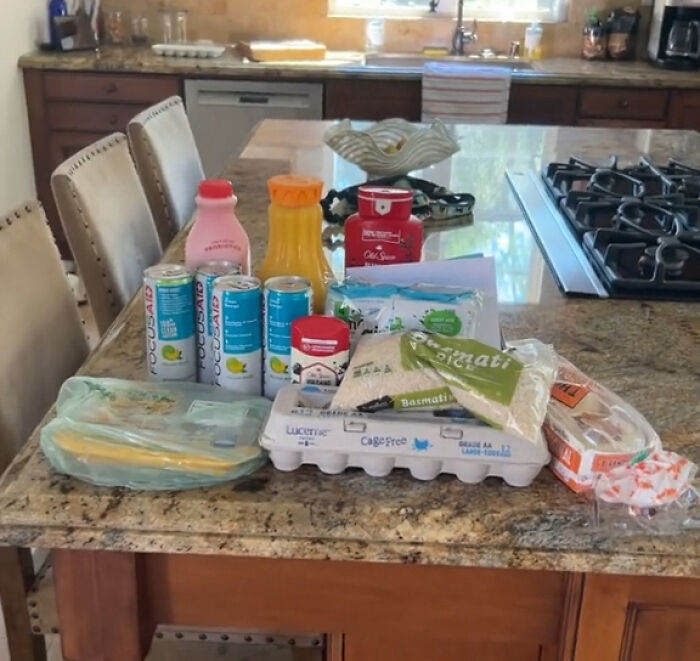

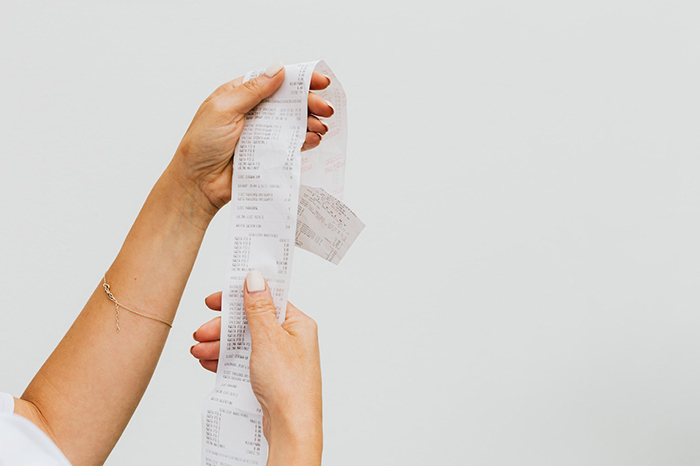








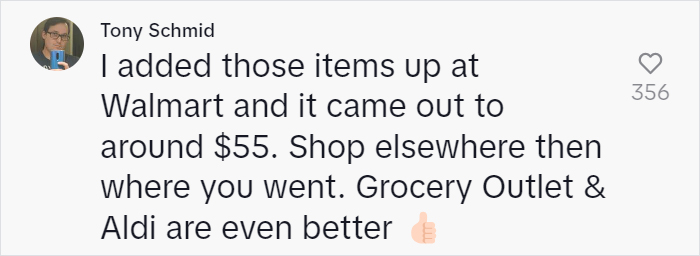

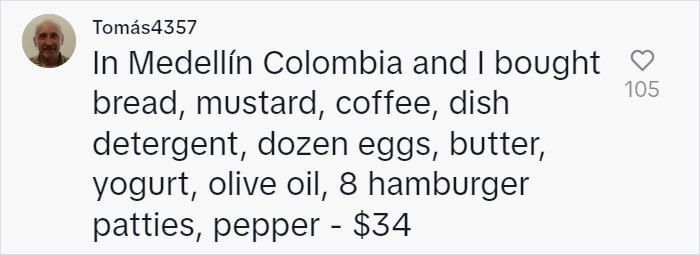





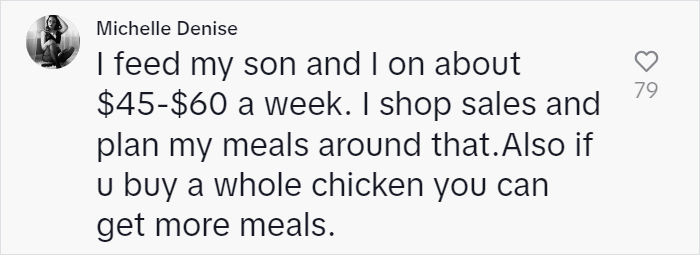













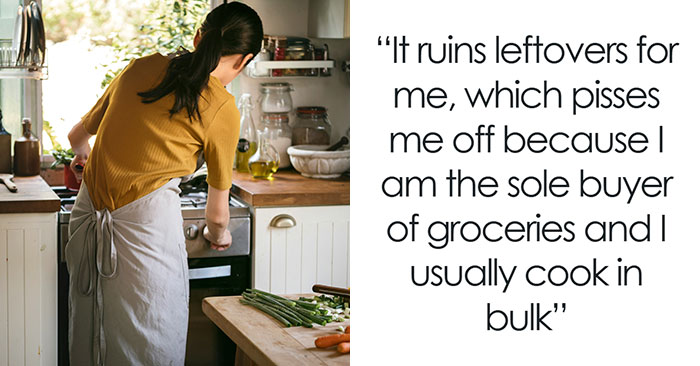






























18
71